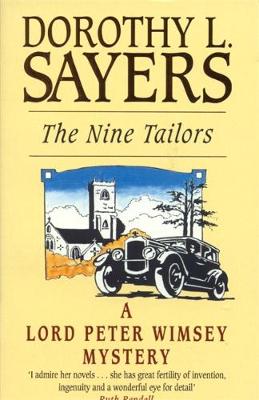
When his sexton finds a corpse in the wrong grave, the rector of Fenchurch St Paul asks Lord Peter Wimsey to find out who the dead man was and how he came to be there. The lore of bell-ringing and a brilliantly-evoked village in the remote fens of East Anglia are the unforgettable background to a story of an old unsolved crime and its violent unravelling twenty years later.
'I admire her novels ... she has great fertility of invention, ingenuity and a wonderful eye for detail' Ruth Rendell
This was one of the few remaining Whimsey books I had left to read; not being English by birth, and ignorant of the art behind bell ringing, I'd naturally thought this was a mystery about tailors; you know, those that produce clothing. I was set straight a few of years ago, and became determined to read it, because a mystery about bell ringing sounded a LOT more interesting.
Nine Tailors was both what I did and didn't expect. From what I'd picked up about bell ringing by osmosis, I knew it was going to be one of the more esoteric mysteries, so I was going to have to depend a lot on context, or spend a lot of time googling. But I didn't expect the almost thriller-ish pacing towards the end, especially as the rest of the book was almost languid in it's exploration of the murder of the stranger in the tower.
In a genre where Cabot Cover Syndrome abounds, with a dozen murders in a small town/village occurring within months is the norm, it's refreshing to pick up a golden age mystery where – time passes –. Indeed, it's 6 months or so before the readers are given a partial solution, and it's almost a year to the day before the true nature of the killing is understood.
If the esoteric nature of the plot aren't a barrier for the mystery lover, there's an outstanding mystery to be had. Several classic elements are here: coded messages, riddles, cold crimes, treasure, and intrigue in graveyards. It's not strictly a perfect mystery - the cold crime in question starts out with three men clearly involved, but later in the book that third man is discarded; this totally left me confused later in the book, forcing me to go back and re-read earlier sections to get back on track.
Ultimately, I figured out both identity and cause of death well before Whimsey, but it didn't affect my enjoyment of the story - indeed, Sayers, in all her mastery, created a fair play mystery where I, as a reader, was actively trying to figure it out, and I had the clues I needed to do it. But even more than this, Sayers created a story where I was invested in the village of Fenchurch St. Paul; I needed to know about the fate of the village and villagers more than I needed to know whether or not I was right. When Whimsey figured out how the man died, and I learned whether I was right or not, it was, as I believe Sayers intended, rather anticlimactic and merely a footnote in light of the events that came before.
I didn't go with a higher rating because I think I'm going to need to re-read this one in order to appreciate the work as a whole. There's a feeling that there's a complexity to the writing and story telling that I missed the first time around; I was too focused on the trees to fully appreciate the majesty of the forest. But even so, it's a book I would not hesitate to recommend to anyone who appreciates fine writing and an excellent mystery.
Reading updates
-
2 June, 2019:
Started reading
-
6 June, 2019:
Finished reading
-
6 June, 2019:
Reviewed
